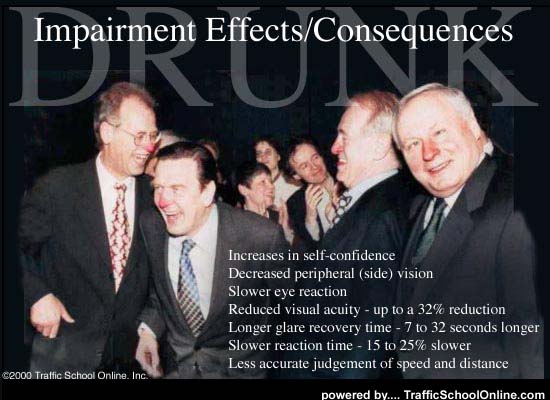|
How Do You Know When You've Had Enough?
How do you know when you've
had too much? Asking someone intoxicated if he or she has had "enough"
is a wasted effort. Most people do not have the judgment to make that
decision once they are intoxicated. You are asking someone with
impaired judgment and reason to use judgment and reason. Sort of
foolish, isn't it? You need a standard for judging intoxication that is
independent of your "feelings" when you have been drinking. That
standard is "Blood Alcohol Content" (BAC). By understanding BAC, you
can know when enough is enough.
Blood Alcohol Content (BAC)
Blood Alcohol Content is an
indication of how many milligrams of alcohol per 100 milliliters of
blood (in milligrams percent) are in the body. In California, a BAC of
.08% is considered legally drunk. That means if you are driving with
that concentration of alcohol in your blood, you are subject to arrest,
fines, confinement, and/or loss of license. If you are under the age of
twenty-one, you are considered legally drunk if your BAC is .01%. In
other words, since it is illegal for someone under the age of
twenty-one to be drinking in the first place, the slightest trace of
alcohol in his or her blood constitutes legal intoxication. To
understand BAC, keep these standards in mind:
A standard drink of alcohol is:
- One-and-one-half ounces of liquor such as Bourbon, Scotch, Vodka, etc. (40% alcohol or 80-proof)
- One five-ounce glass of table wine (12% alcohol)
- One 12-ounce container of beer (5% alcohol)
Note: One standard drink of hard
liquor is a "jigger," which is one-and-a-half ounces. Some table wines
have more than the typical 12% alcohol, and some imported beers have
higher alcohol content. A 12-ounce container of beer has the same
amount of alcohol as a mixed drink made with one-and-a-half ounces of
80-proof liquor. Ten beers are the equivalent of ten standard mixed
drinks!
Alcohol Absorption
Alcohol is the only
ingested substance that undergoes no digestion. Once it is in your
stomach, it is absorbed directly into the bloodstream. Time, body
weight, and stomach contents affect absorption rates.

Time:
Alcohol is a fuel the body burns up fairly quickly. But not quickly
enough in many instances since drinkers underestimate the amount of
time needed to burn the alcohol they have ingested. The liver is the
organ responsible for burning alcohol, and, as you might already know,
cirrhosis of the liver can be a side effect of alcoholism. In an adult
male with good liver function, the liver can process approximately one
ounce of alcohol an hour. The average rate of metabolism will
metabolize 0.015% BAC per hour. This means that
the average adult male body can dissipate one drink in about
one-and-one-quarter hours. For the average adult female it takes about
one-and-one-half hours to dissipate one standard drink. So,
theoretically, if you are male and have one standard drink of alcohol
at 7:00 p.m., your blood alcohol at 8:15 p.m. will be 0.00. For an
average woman it will take until 8:30 p.m.
Body Size:
Another important factor in your blood alcohol content is your body
size. Body mass and blood volume affect the amount of alcohol in a
person's bloodstream and therefore the time it takes for a person to
feel the effects of alcohol. In general, the bigger you are, the more
alcohol you can consume. If a 200-pound person and a 100-pound person
drink the same amount of alcohol in the same time period, the smaller
person will become intoxicated quite a bit before the larger person.
Stomach Content:
Since alcohol has to be absorbed to have an effect, anything slowing the
absorption will slow the effect. Taking alcohol on an empty stomach
guarantees an almost immediate effect as the alcohol hits the blood and
quickly goes to the brain. Here, it initiates its effects. "Don't drink
on an empty stomach" is good advice. However, just because the food is
slowing absorption, do not mislead yourself to think it is preventing
absorption. The effects of alcohol you drink on a full stomach will be
the same. It will just take a little longer.
Small amounts of alcohol are
eliminated through sweat, breath, and urine leaving the body unchanged
as alcohol; but the main way the body disposes of alcohol is through
chemically breaking it down. This process occurs at a steady metabolic
rate, and nothing hastens it. Nothing. Not cold showers, exercise, or
hot coffee. If you give coffee to someone who is drunk hoping the
caffeine will sober him, all you will have is a wide-awake drunk. |